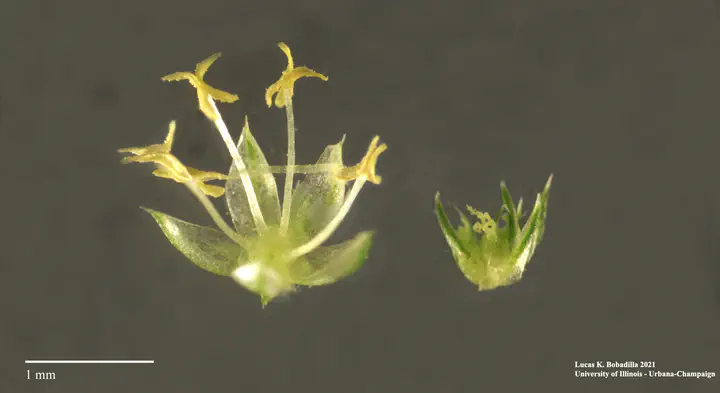Gender determination mechanism in dioecious Amaranthus species
 Male and female flowers of Amaranthus tuberculatus
Male and female flowers of Amaranthus tuberculatusContemporary agriculture must evolve to meet the challenges of achieving high yields in a sustainable fashion to feed a growing population. Among these challenges, weed management continues to be of high priority due to the constant evolution and adaptation of weeds to chemical management practices (Perotti et al. 2020, Renton et al. 2014). Collectively, waterhemp (Amaranthus tuberculatus (Moq.) Sauer) and Palmer amaranth (Amaranthus palmeri S. Wats.) are considered driver weed species throughout much of the US. In fact, recent surveys by the Weed Science Society of America (WSSA) classified these two weeds as the most troublesome in corn, and two of the three most troublesome in soybean.
The two species are herbaceous, annual plants native to the American Midwest and Southwest (Sauer 1955), with many attributes contributing to weediness, including high photosynthetic rates, rapid growth rates, and germination periods that extend throughout much of the growing season (Costea et al. 2005, Ward et al. 2013). However, the main attribute that makes these weeds so troublesome is their ability to rapidly and repeatedly evolve resistance to herbicides (Steckel 2007): to date, waterhemp and Palmer amaranth have evolved resistance to herbicides spanning seven and eight modes of action, respectively.
The weediness characteristics of waterhemp and Palmer amaranth are shared—at least to some extent—by many of the other Amaranthus weeds [e.g., redroot pigweed (A. retroflexus)]. Setting waterhemp and Palmer amaranth apart, however, is their dioecy characteristic. Whereas most other Amaranthus species are monoecious and predominantly self-pollinated, separate female and male plants of the dioecious species ensures outcrossing. This high rate of outcrossing promotes genetic diversity, rapid adaptation, and efficient “stacking” of multiple herbicide-resistance traits, leaving producers with few effective herbicide choices.
Dioecy can be defined as the presence of male and female individuals within a plant species. Dioecy is not common, present in about 6% of angiosperms. Despite its infrequency, however, dioecy has evolved independently in several lineages and is found in many important species [e.g., spinach (Spinacia oleracea), asparagus (Asparagus spp.), hops (Humulus spp.), cannabis (Cannabis spp.), kiwifruit (Actinidia spp.), papaya (Carica papaya), fig (Ficus carica), persimmon (Diospyros kaki), grape (Vitis vinifera), strawberry (Fragaria spp.) and willow (Salix spp.)
Dioecy provides several advantages and potential disadvantages to the success of a species. Separate sexes enforce outcrossing, favor high heterozygosity and associated heterosis, and can lead to plants being more efficient in their reproductive role. For example, female plants could invest more energy into seed production, providing more resources to their progeny.
Recent advances were made to identify male-specific Y (MSY) regions within A. tuberculatus and A. palmeri utilizing male-specific markers with the genome sequence and the identification of the MSY region in each species. The MSY regions in A. palmeri and A. tuberculatus span about 1.3 Mbp and 4.6 Mbp, respectively. Consistent with the hypothesis that dioecy evolved separately in the two species, synteny was not detected between the two species’ MSY regions. Even though the MSY identification led to a considerable advance in the diecious mechanism elucidation, no precise candidate gene was identified. This gap can be filled by the transcriptomics comparisons across genders to narrow down further putative candidates for sex-determination in dioecious weedy Amaranthus species.
The focus of my studies is to fill this gap via RNA-seq and comparative genomics analyses to narrow down de list of putative candidates for sex-determination in Amaranthus species.
Currently, the manuscript for it was submitted and it is under review.